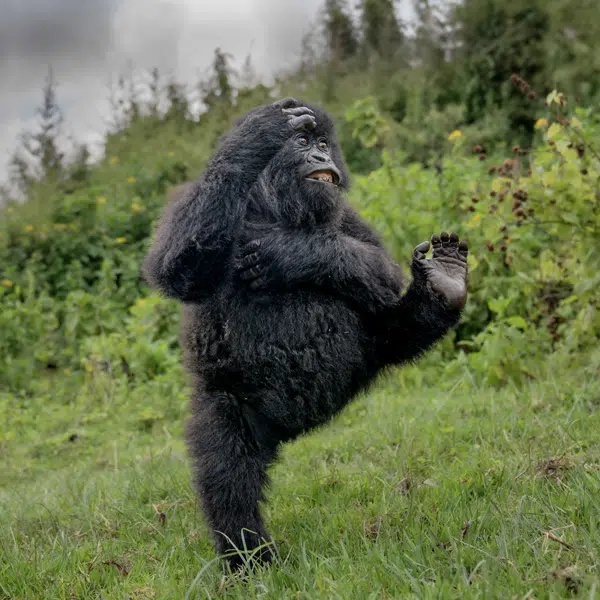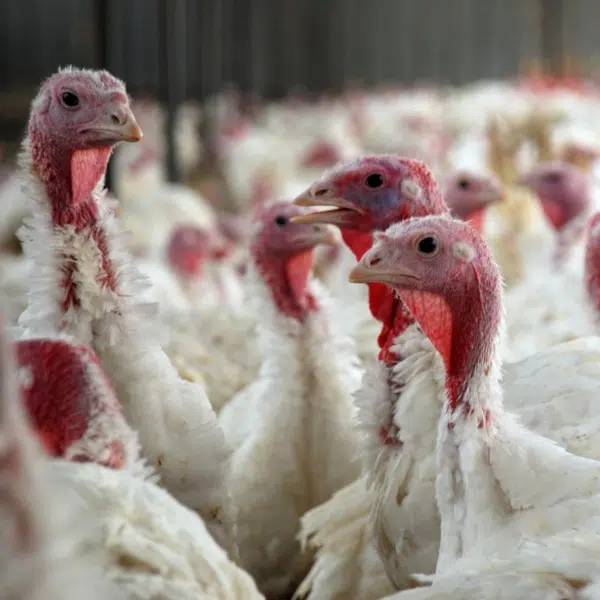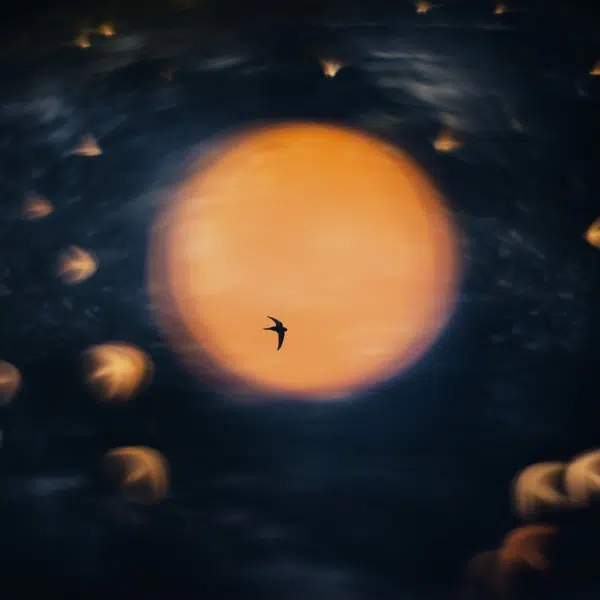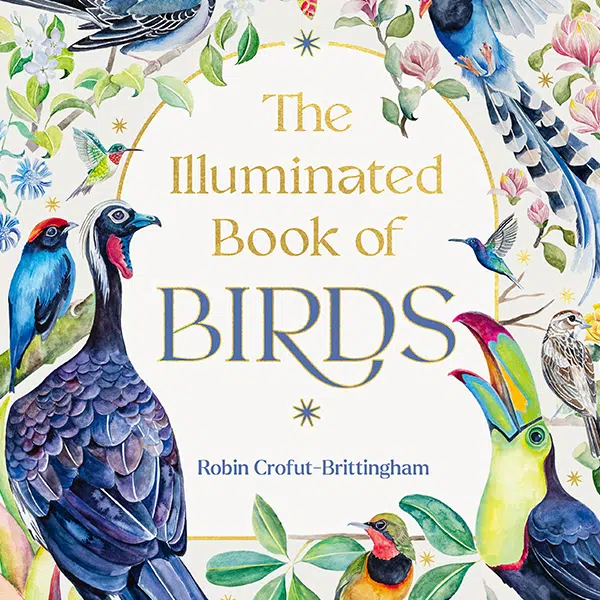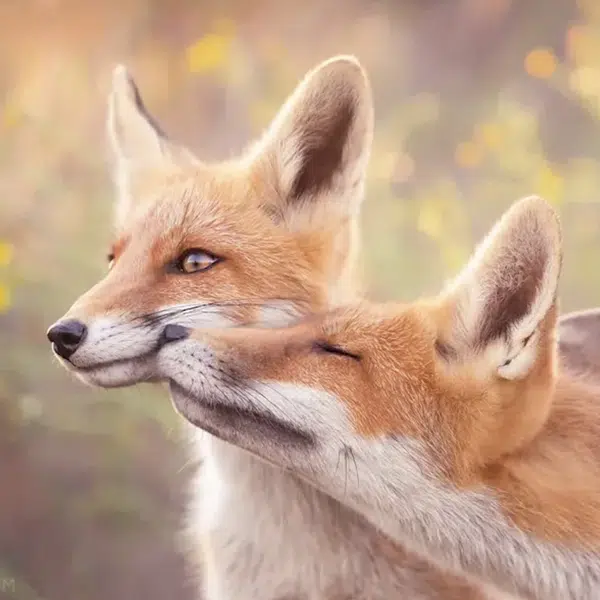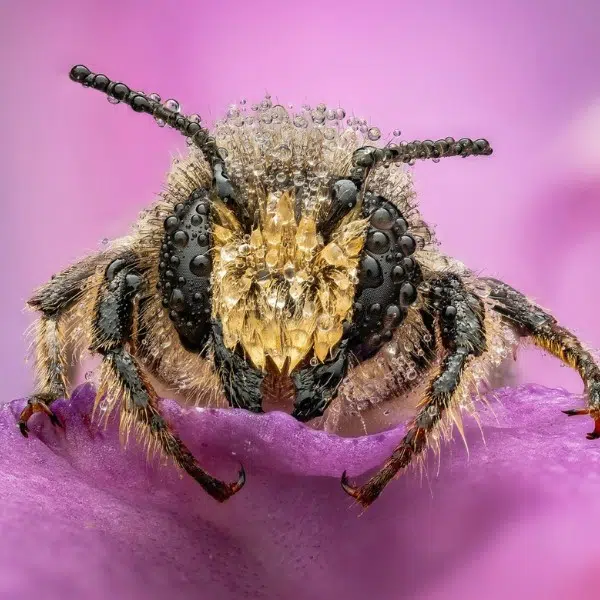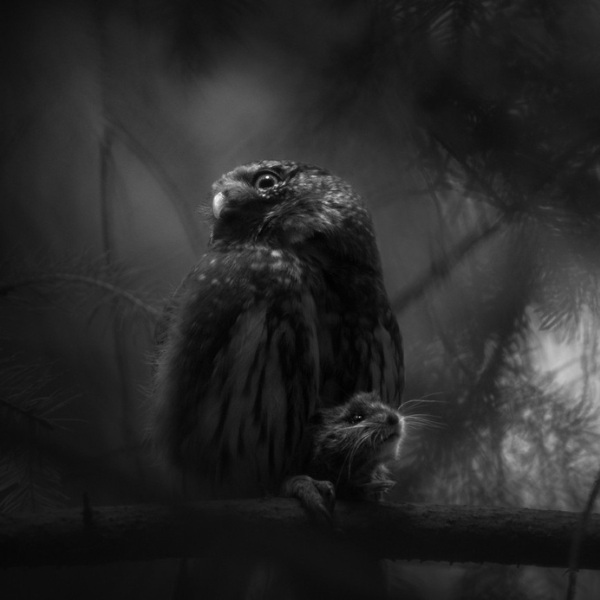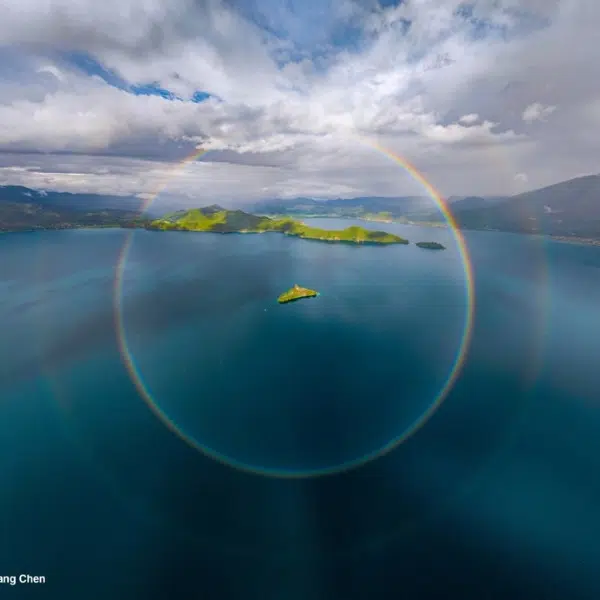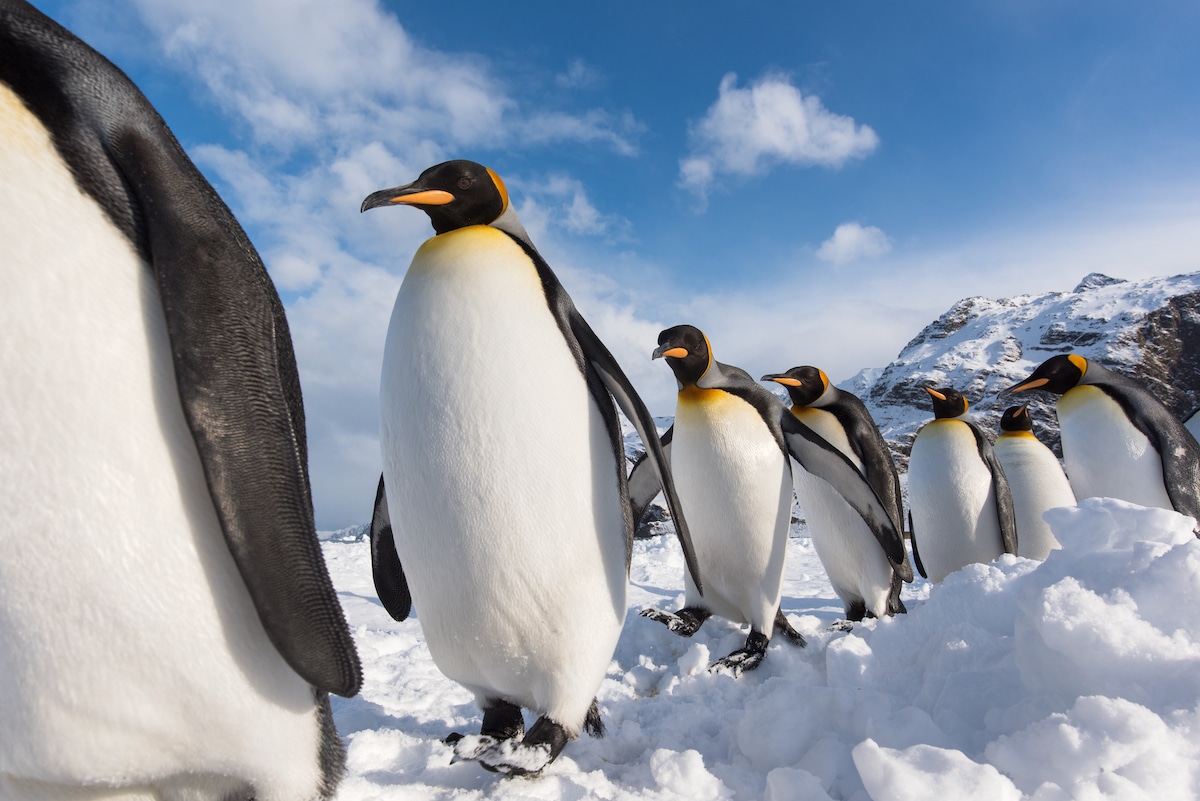
“Single File” by Ben Cranke (South Africa)
Bird: King Penguin Aptenodytes patagonicus.
Location: Gold Harbour, South Georgia, South Georgia.
Category: Best Portrait.
On land, King Penguins tend to be creatures of habit, and when moving from the sea to their nests they usually follow a well-trodden path. I took advantage of this behavior to capture this image, hiding a camera on the edge of one of these paths and camouflaging it with snow. I used a wireless trigger to take this shot of the birds as they paraded past in an orderly single file.
Nikon D810 with Nikon 18–35mm f/3.5–4.5 lens. Focal length 23mm; 1/500 second; f/11; ISO 200.
Now in its seventh year, the Bird Photographer of the Year contest is a celebration of the avian world. For the 2022 edition, more than 20,000 images from 115 countries were submitted for consideration. And while the winners won't be announced until September, the competition is giving us a sneak preview of some of the finalists across several categories.
A selection of finalists from the Best Portrait, Bird Behaviour, and Conservation Award categories shows the strength of this year's competition. The photographs, which were taken in diverse locations around the world, reveal the diversity of birds. From the signature black-and-white feathers of king penguins to the wart-covered head and neck of an ocellated turkey, the finalist portraits draw out the best features of these animals.
The Bird Behaviour category runs the gamut from elaborate mating rituals to vicious fights. In the mix is also a beautiful, maternal moment of a hummingbird feeding its young, taken right in the photographer's local park. For the prestigious contest, intimate moments like this are part of what makes birds special.
“Birds are an incredibly diverse group of animals, and we’ve seen stunning images of everything from mallard ducks to harpy eagles this year,” says Will Nicholls, wildlife cameraman and director at Bird Photographer of the Year. “We celebrate birds and conservation through images, and it is always a pleasure for everyone on the judging panel to see the work of such talented photographers.”
The winners of the international competition will be announced on September 8, 2022. Not only will the winners receive a cash prize, but they will also be part of the 2022 competition coffee table book and participate in a traveling exhibition.
Preview some of the finalists of the 2022 Bird Photographer of the Year competition.
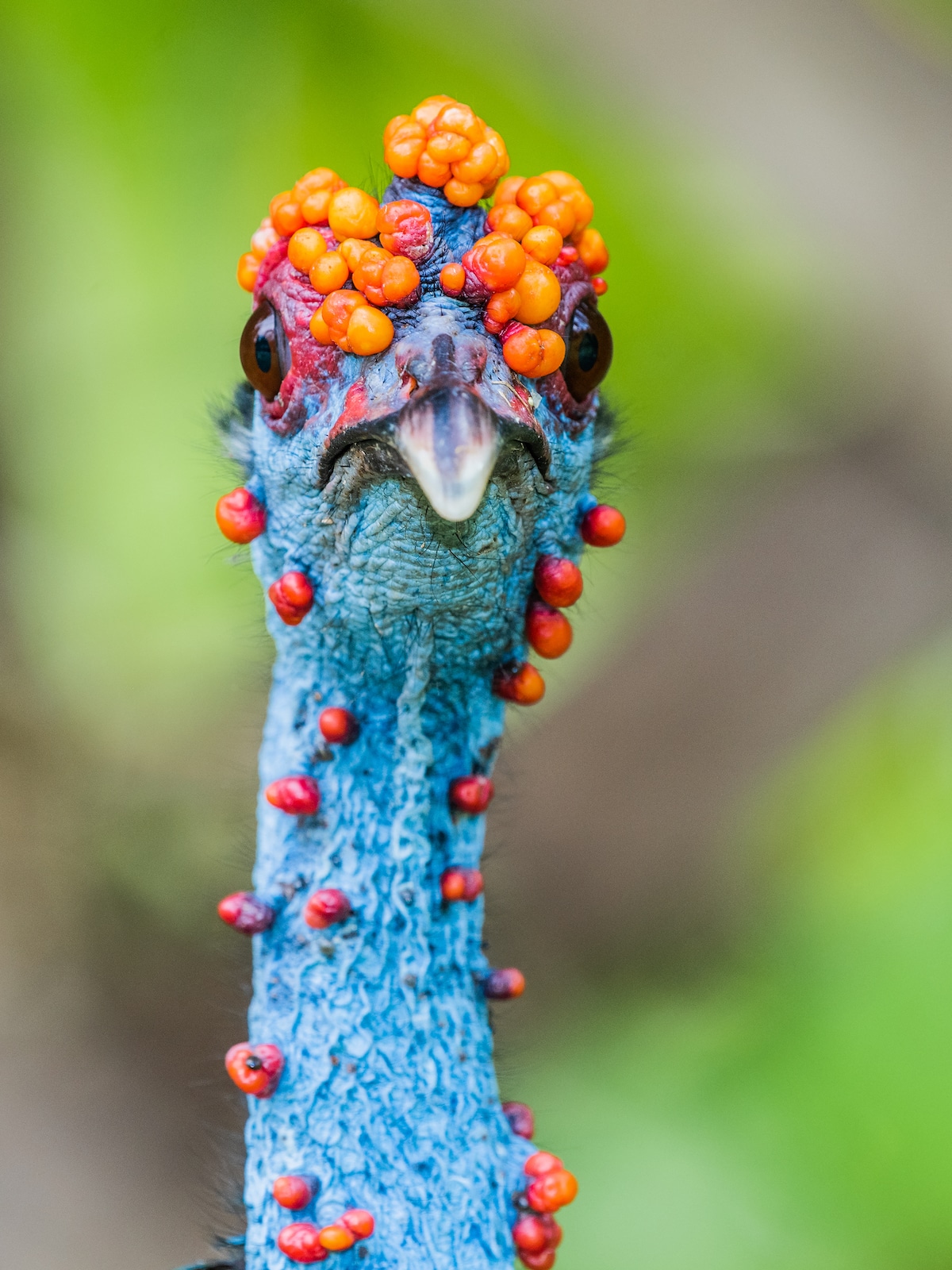
“Wart Head” by Leander Khil (Austria)
Bird: Ocellated Turkey Meleagris ocellata.
Location: Chan Chich, Belize.
Category: Best Portrait.
The colors and structures on the head of a male Ocellated Turkey surpass even those of its closest relative, the Wild Turkey (Meleagris gallopavo) of North America. I always wonder whether the orange warts that cover the head and neck could serve any other purpose than sexual selection
– they seem so extravagant. To show the birds in a different way than is seen usually, I chose this head-on view when this individual made eye contact with me in a private reserve in Belize.
Nikon D810 with Nikon 200–500mm f/5.6 lens. Focal length 500mm; 1/250 second; f/6.3; ISO 500.
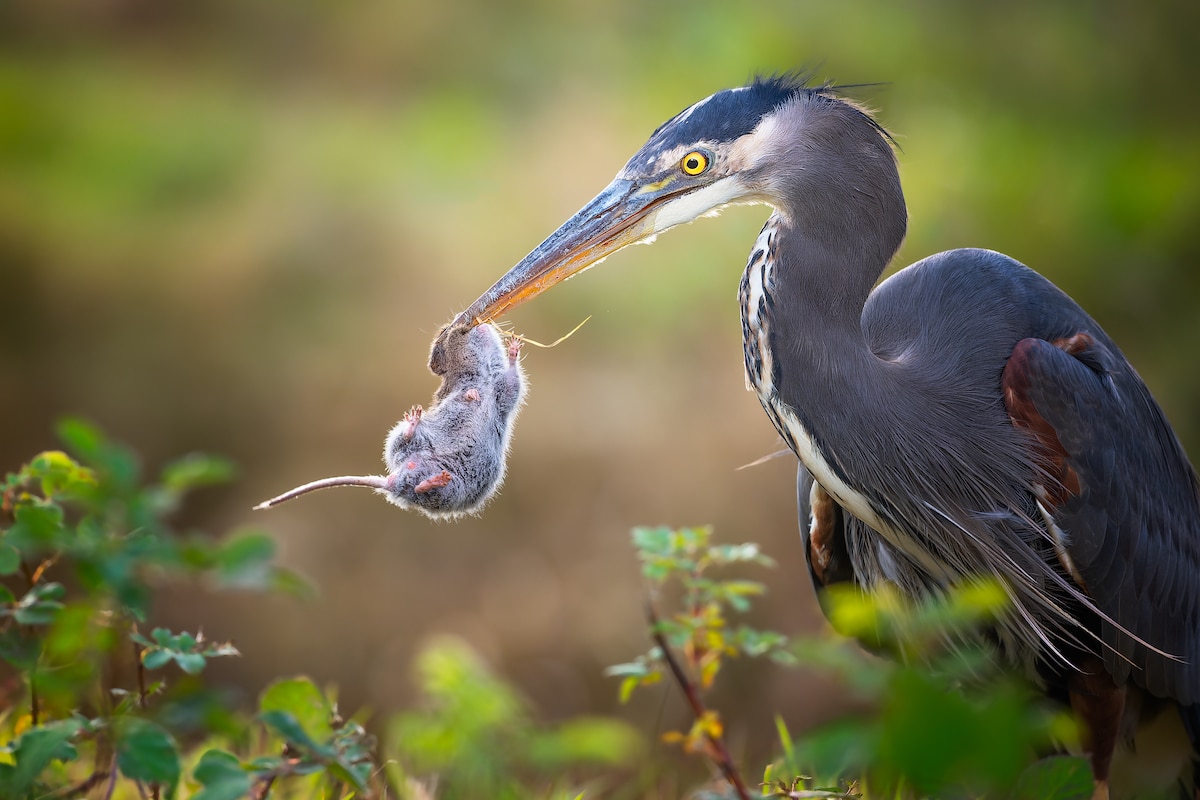
“Life Hanging in the Balance” by Glenn Nelson (USA)
Bird: Great Blue Heron Ardea herodias.
Location: Skagit Valley, Washington State, USA.
Category: Bird Behaviour.
I’d spent a good portion of the year photographing Great Blue Herons, which is the official bird of my hometown, Seattle. I had just taken possession of a brand-new lens and wanted to try something different, so I pulled off the road to observe a heron in a field. Until that point, I had been photographing these birds exclusively in the vicinity of water. I was shocked when the bird pulled up a vole and I literally had to force myself to keep photographing. Some will find this image too gruesome to look at, and the heron’s choice of prey will come as a surprise to many. It really should not: we humans devour other mammals, as well as birds, after all.
Nikon Z 6 with Nikon 500mm f/5.6 PF lens. Focal length 500mm; 1/3,200 second; f/5.6; ISO 2,800.
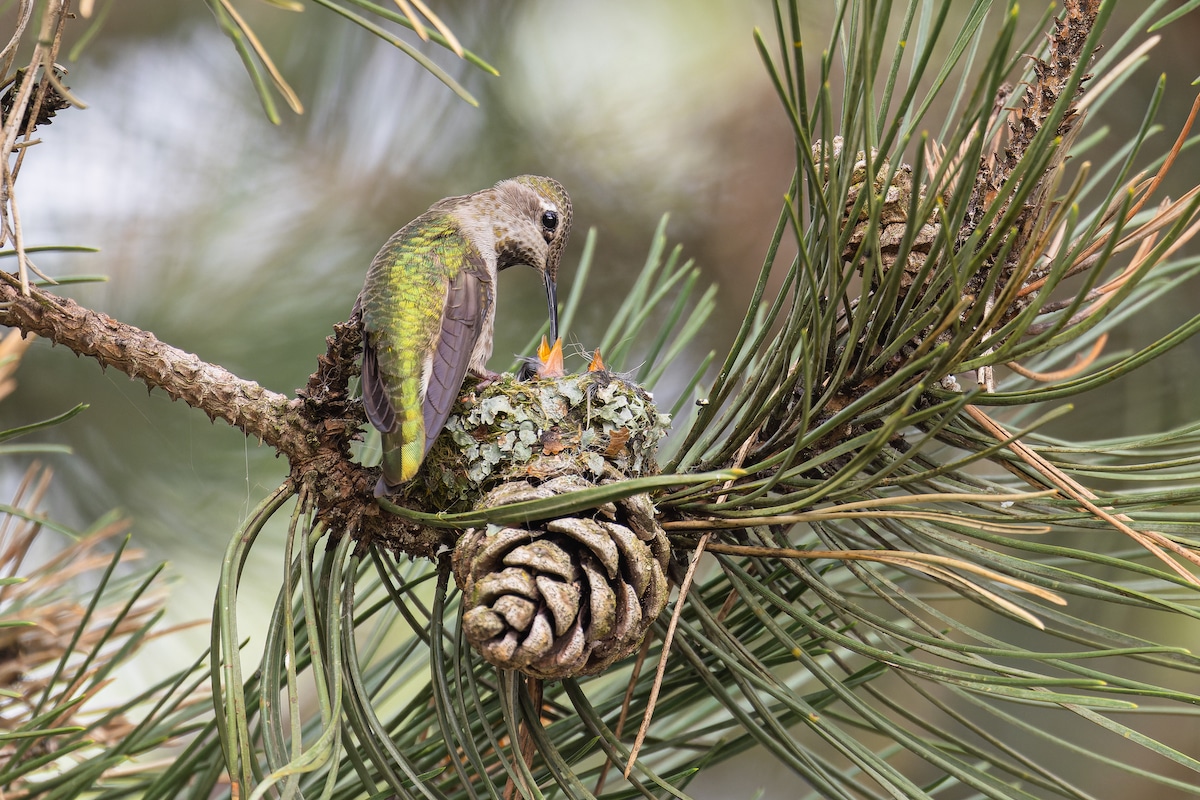
“Hummingbird Hideaway” by Liron Gertsman (Canada)
Bird: Anna’s Hummingbird Calypte anna.
Location: Vancouver, British Columbia, Canada.
Category: Bird Behaviour.
During the Covid-19 pandemic, travel restrictions meant that my photographic pursuits were limited to my immediate neighborhood for quite some time. I decided I would take the opportunity to get to know my local area in Vancouver as well as possible. Each morning, I ventured out to a local park, searching for birds and wildlife. Over the course of the spring, I managed to locate seven Anna’s Hummingbird nests in the area. Not wanting to disturb the birds in this important and sensitive stage of their life cycle, I would stay an appropriate distance from the nests and limit my visits to a maximum of 15 minutes. I had been checking in on this particularly beautiful nest for a couple of weeks, as a hummingbird worked hard to build it and incubate her eggs. I was delighted when I stopped by one afternoon and saw two tiny beaks poking out of the tiny nest! When their mother flew in to feed them, I captured this intimate moment.
Canon R5 with Canon 100–400mm f/4.5–5.6 II lens and 1.4× teleconverter. Focal length 560mm; 1/160 second;
f/8; ISO 800.
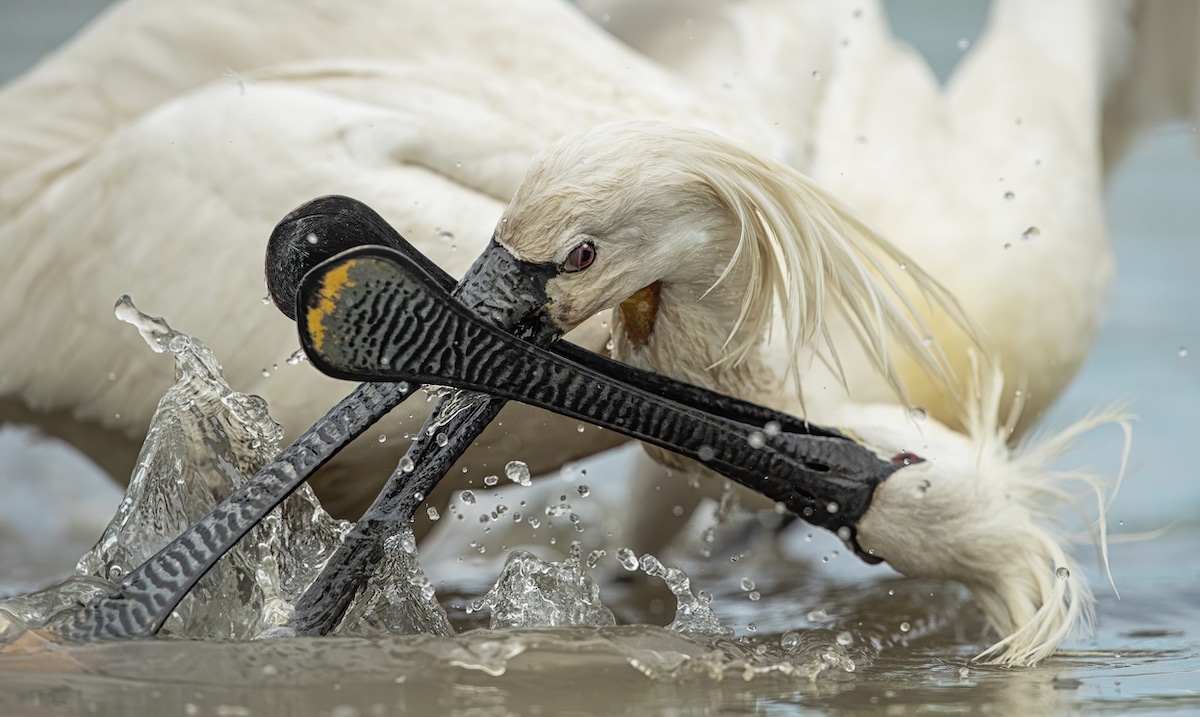
“Full Contact” by Gabor Baross (Hungary)
Bird: Eurasian Spoonbill Platalea leucorodia.
Location: Hortobágy National Park, Hungary.
Category: Bird Behaviour.
This image was taken on my second photographic session at this small pond. On my first visit there had been plenty of birds and lots of possibilities to take action photos. However, now the silence was my partner. All I had seen was a lone Grey Heron (Ardea cinerea) that attacked every bird that approached the pond. However, in the afternoon the situation had improved and a group of Eurasian Spoonbills landed not far away from me. It was immediately noticeable that there was an aggressor among them, a bird that had very strong territorial instincts. I focused my attention and camera on this bird. In the vast majority of cases, the other spoonbills chose to avoid confrontation. However, in one instance there was a bird that turned to face the aggressor and a minute of unbridled fighting began. The level of aggression the birds displayed was far beyond my imagination. I felt like they were fighting for their lives, as they pressed each other’s heads under the water or just grabbed each other’s legs and did not let their rival fly away. During the combat they were getting closer and closer to me, so by the time this picture was taken they completely filled the frame.
Canon EOS-1D X Mark II with Canon 400mm f/2.8 lens. Focal length 400mm; 1/6,400 second; f/4; ISO 1,000.
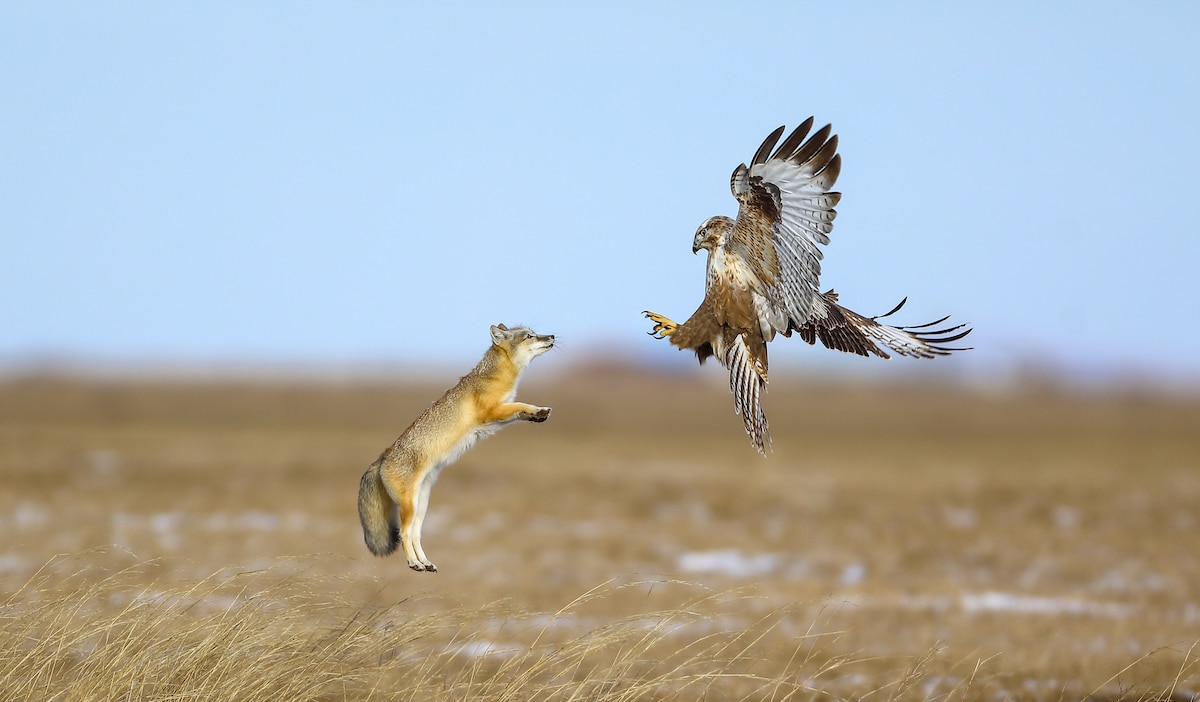
“Upland Buzzard Versus Corsac Fox” by Baozhu Wang (China)
Bird: Upland Buzzard Buteo hemilasius.
Location: Inner Mongolia Autonomous Region, China.
Category: Bird Behaviour.
This photograph was taken on the Mandu grasslands of Dongwu Banner in Inner Mongolia. Both Upland Buzzard and Corsac Fox (Vulpes corsac) are top predators in this grassy environment and share a diet that comprises mainly small rodents. Consequently, in terms of feeding they are rivals and are sometimes driven to fight each other over food. This kind of confrontation is usually for show and a battle of will that never ends up with life-and-death conflict. In this instance, the Upland Buzzard decided to relinquish its food and fly away.
Canon EOS 5D Mark IV with Canon 600mm f/4 lens. Focal length 600mm; 1/1,600 second; f/4, ISO 160.
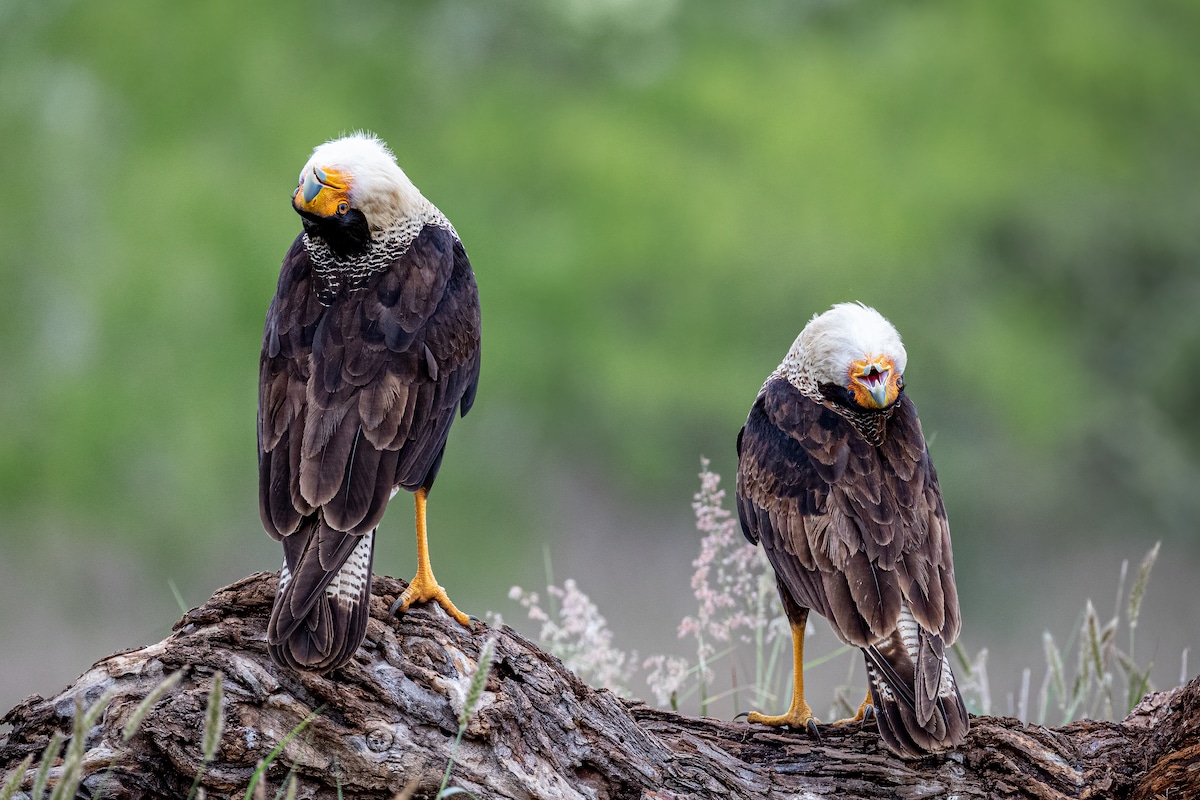
“Head Over Heels in Love” by Marti Phillips (USA)
Bird: Crested Caracara Caracara cheriway.
Location: Laguna Seca Ranch, Edinburg, Texas, USA
Category: Bird Behaviour.
I traveled to the Rio Grande area in Texas to attend my first bird photography workshop. This image was taken from a hide where birds are fed regularly, and among the species attracted were Crested Caracaras. Most of the time they just sat around, so imagine my delight at being able to photograph these two individuals as they performed their mating behavior.
Canon EOS 5D Mark IV with Canon 100–400mm f/4.5–5.6 II lens. Focal length 400mm; 1/500 second; f/5.6; ISO 2,000.
The winners of the prestigious photo contest will be announced in early September.
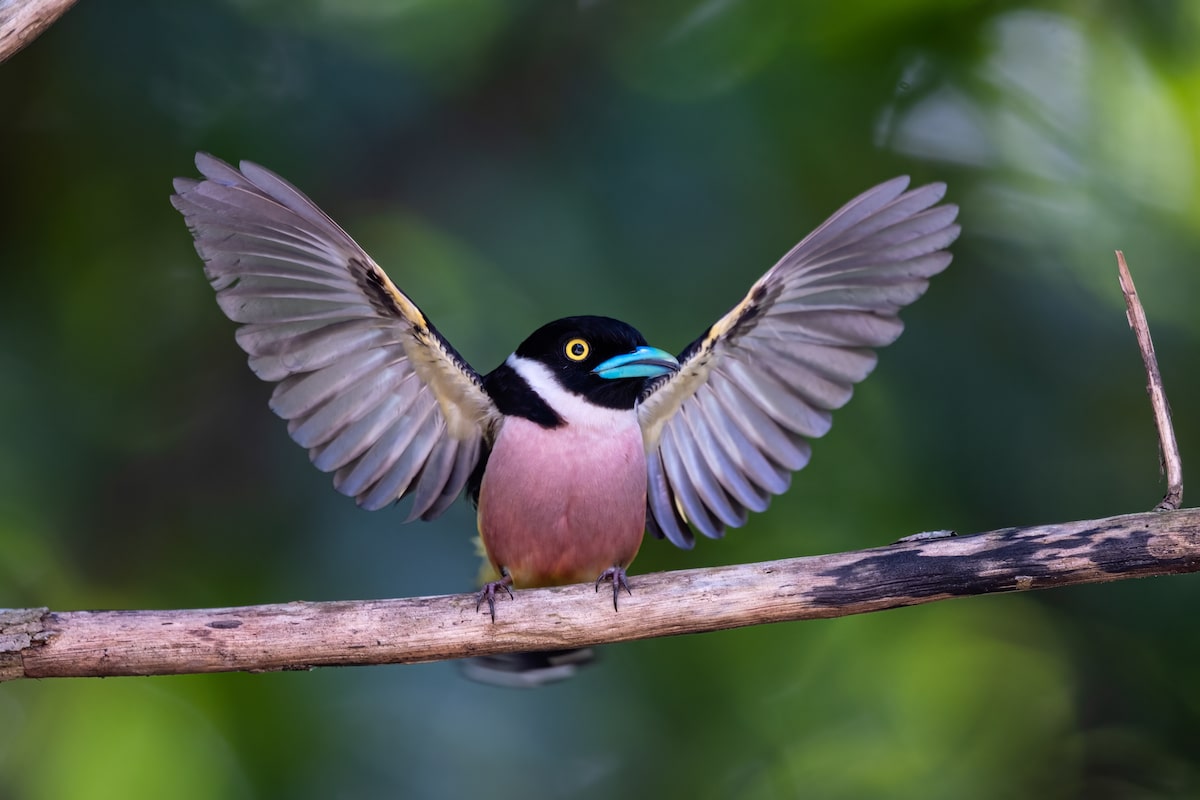
“A Cartoon Bird Raising Its ‘Hands'” by Weng Keong Liew, (Malaysia)
Bird: Black-and-yellow Broadbill Eurylaimus ochromalus.
Location: Selangor, Malaysia.
Category: Best Portrait.
It was the start of the breeding season, and this Black-and-yellow Broadbill was making a lot of commotion in an attempt to attract a mate. The courtship behavior included a lot of noisy vocalization and attention-seeking wing-
spreading. To my eyes the plumage colors and patterns are like those an artist would use to illustrate a cartoon – stylized and somehow not quite like a real bird.
Fujifilm X-T4 with Canon 500mm f/4 II lens. Focal length 500mm; 1/250 second; f/4.5; ISO 400.
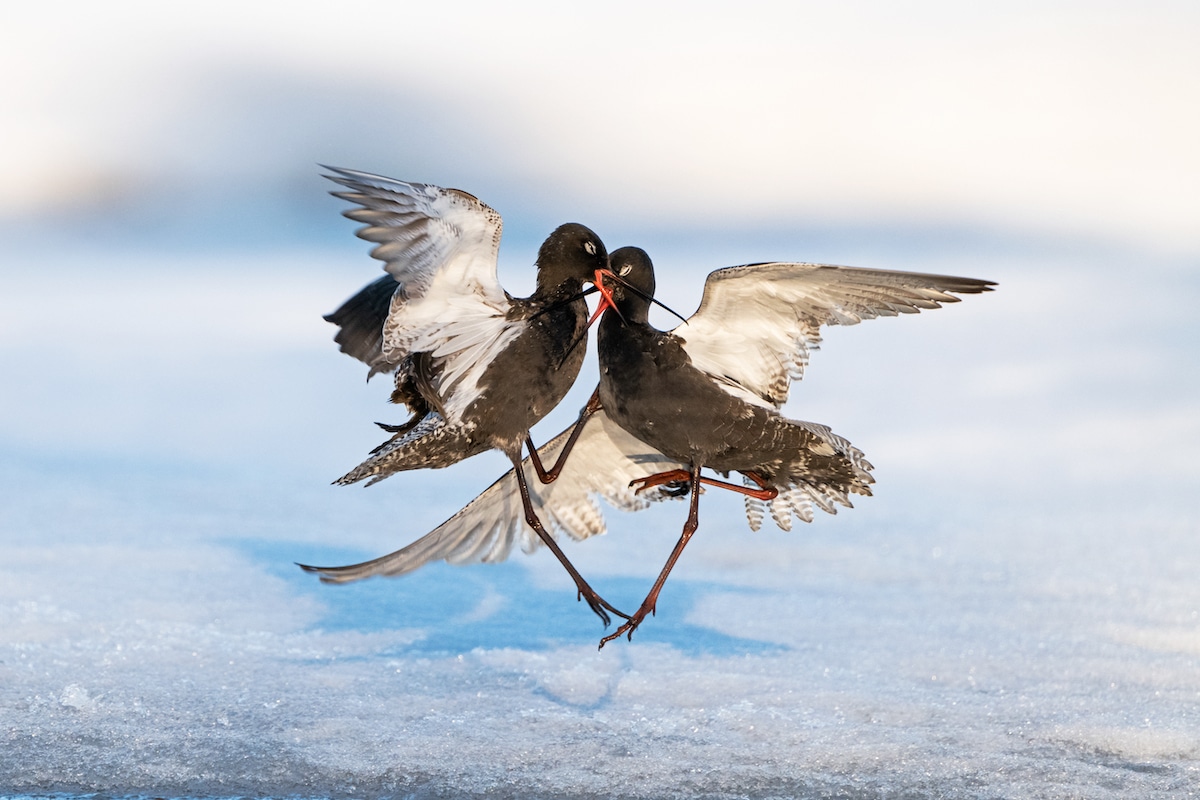
“Fight” by Erlend Haarberg (Norway)
Bird: Spotted Redshank Tringa erythropus.
Location: Finnmark, Norway.
Category: Bird Behaviour.
In 2020, spring was late arriving in Finnmark and there was still a lot of lingering snow when the first migratory birds arrived. As a result, there were only a few spots with open water on this particular river, and many waders gathered there in search of food while they waited for the snow to melt on their nesting grounds. I spent several days in my hide and was able to witness some interesting behavior, including brutal battles between rival males, perhaps fueled by frustration at being snowbound. The most impressive took place between these two Spotted Redshanks.
Nikon D850 with Nikon 180–400mm f/4 lens and 1.4× teleconverter. Focal length 550mm; 1/2,500 second; f/6.3; ISO 1,600.

“Gentoo Dancing at Sunset” by Audrey Wooller (United Kingdom)
Bird: Gentoo Penguin Pygoscelis papua.
Location: Sea Lion Island, Falkland Islands.
Category: Best Portrait.
In the light of the setting sun, this penguin almost looked as if it were dancing. I positioned myself lying on the ground, waiting and hoping for a suitable penguin to pass during the few minutes when the setting sun created ideal light for a silhouette. This penguin obliged, with beak, feet and flippers nicely placed as it went past. I intentionally underexposed the image slightly to enhance the colors of the sunset against the silhouetted penguin.
Canon EOS-1D X Mark II with Canon 100–400mm f/4.5– 5.6 II lens. Focal length 371mm; 1/1,600 second; f/5.6; ISO 100.
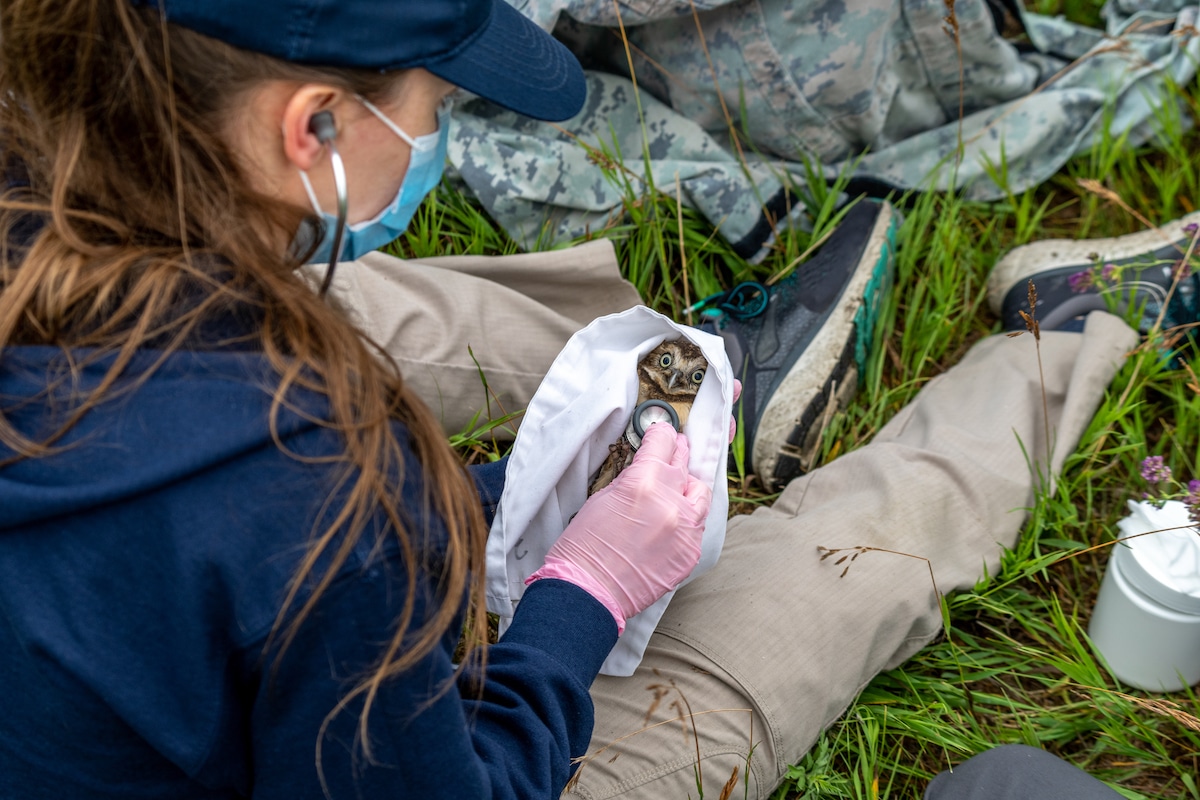
“Manitoba Burrowing Owl Recovery Program” by Walter Potrebka (Canada)
Birds: Burrowing Owl Athene cunicularia.
Location: Manitoba, Canada.
Category: Conservation Award.
I spent 2021 documenting the work of the Manitoba Burrowing Owl Recovery Program. As the project’s name suggests, it is working to re-establish the Burrowing Owl population in Manitoba, Canada. The approach involves the
reintroduction of owl pairs and young, wild owl surveys, habitat improvement and community engagement. Owls are reintroduced every breeding season, with cooperation from private landowners. Despite these efforts, in the last ten years fewer than ten nesting pairs of wild Burrowing Owls have been recorded in Manitoba. To the team’s delight, and thanks to a local farmer, in 2021 a wild nest was reported with six healthy owlets, which was the first nest observed since 2011!
Sony A1 with Sony 70–200mm f/4 G lens. Focal length 70mm; 1/80 second; f/6.3; ISO 320.












































































